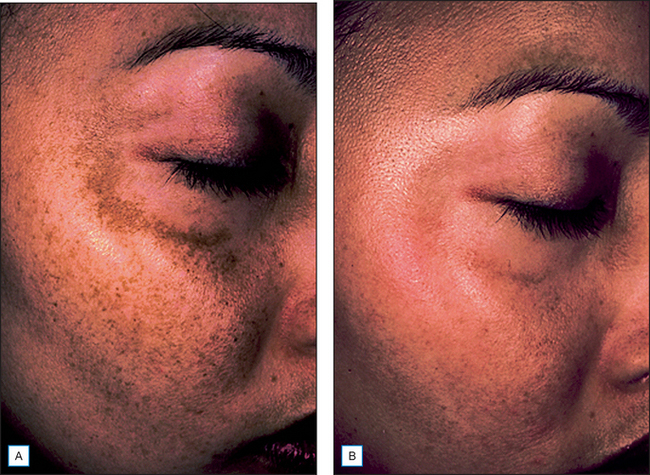Chapter 15 Skin Lightening Agents
INTRODUCTION
Hyperpigmentation is a common skin problem that is particularly prevalent in middle-aged and elderly individuals. It is cosmetically important and can greatly detract from both appearance and quality of life, particularly in cultures where smooth skin is valued as a sign of health or in cultures that are beauty conscious. Hyperpigmented skin lesions may be postinflammatory as a sequel to acne, trauma, chemical peels, or laser therapy. Exogenous causes, particularly ultraviolet (UV) light exposure, are a common factor in pigmentary abnormalities such as melasma, solar lentigines, and ephelides (Fig. 15.1). Exposure to certain drugs and chemicals as well as the existence of certain disease states can result in hyperpigmentation (Box 15.1).
SKIN LIGHTENING COSMECEUTICALS
Multiple depigmenting cosmeceuticals are currently available, although published clinical evidence to support their effectiveness is lacking. These skin lightening compounds work by removing undesired pigment by acting at one or more steps in the pigmentation process (Box 15.2). Since tyrosinase is the rate-limiting enzyme for melanin biosynthesis, many of the cosmeceuticals for skin lightening exert their effect on this enzyme.
Box 15.2 Depigmenting agents and reported effect on the melanin synthetic pathway
Modified from Briganti S, Camera E, Picardo M 2003 Chemical and instrumental approaches to treat hyperpigmentation. Pigment Cell Research 16:1–11.
• Hydroquinone
For many years, the phenolic compound hydroquinone has been the most widely and successfully used skin lightening agent for the treatment of melasma, postinflammatory hyperpigmentation, and other disorders of hyperpigmentation (Fig. 15.2). Hydroquinone occurs naturally in many plants as well as in coffee, tea, beer, and wine. Hydroquinone depigments skin by inhibiting the conversion of tyrosine to melanin. It has been shown to decrease tyrosinase activity by 90%. It may also inhibit DNA and RNA synthesis, as well as degrade melanosomes.
Stay updated, free articles. Join our Telegram channel

Full access? Get Clinical Tree





























